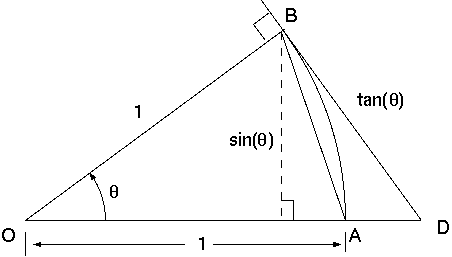
In order to understand the calculus of sin(x) , or any trigonometric
function, we first need to find some limits involving trigonometric functions.
First, we deal with the limit
|

Those three regions are arranged from the smallest to the largest by:
| ||||||||||||||||
Multiply through the second line by 2 and divide by sin(q) , and
you get:
|
This is kind of upside down, so flip these fractions over. That reverses the
inequalities:
|
Now as q heads down to 0, both the outside functions go to 1 (one is there all the time), so the squeeze principle implies that the center one does also.
Don't worry about the fact that this only works for positive values of q,
if a negative value for q is put in, it just changes the sign of
both the top and the bottom. So, you can substitute x for q
above, and not worry about whether it's positive or negative. The limit then
has to be 1:
|
All other trigonometric limits we will need follow from this one.
Copyright (c) 2000 by David L. Johnson.